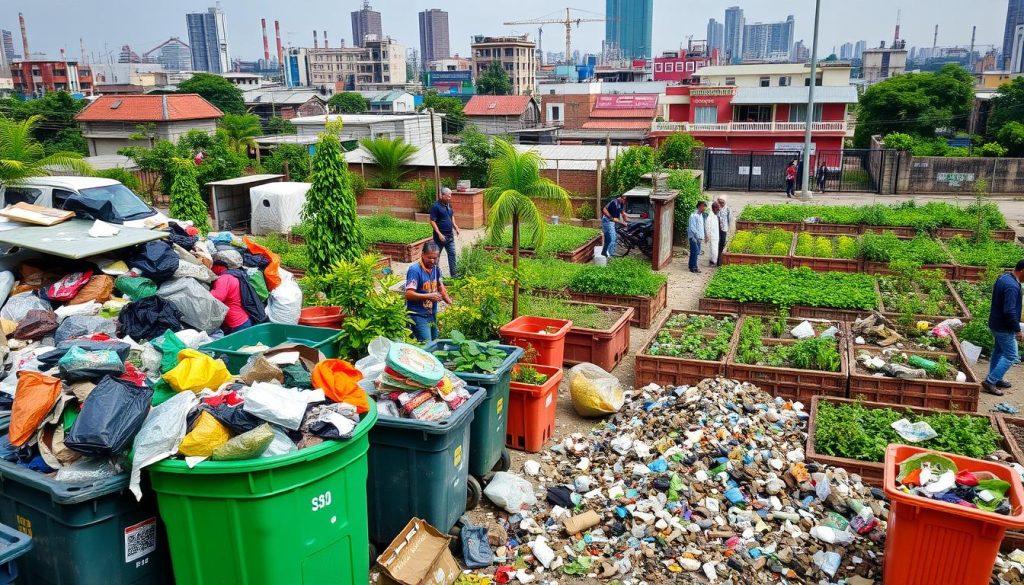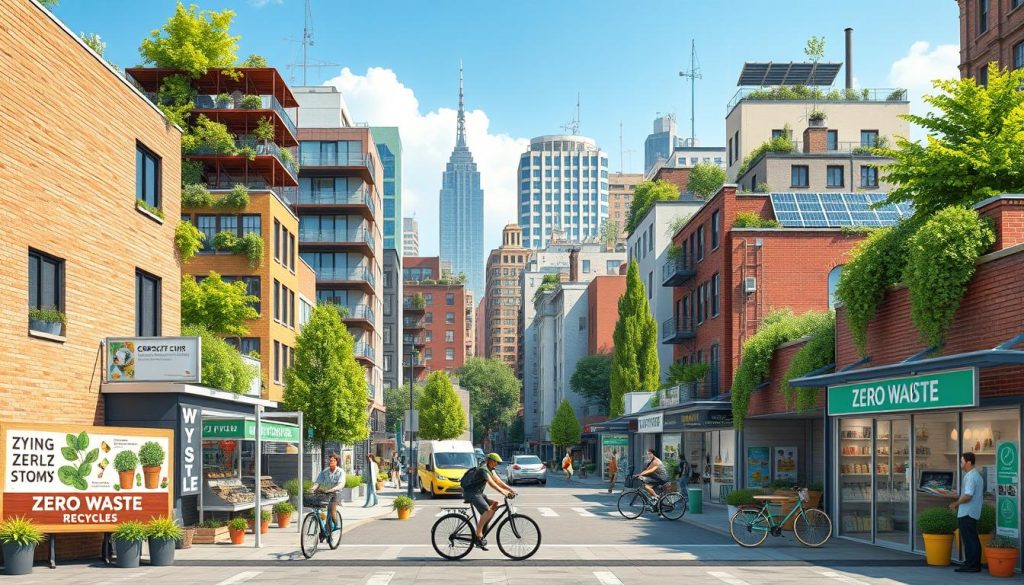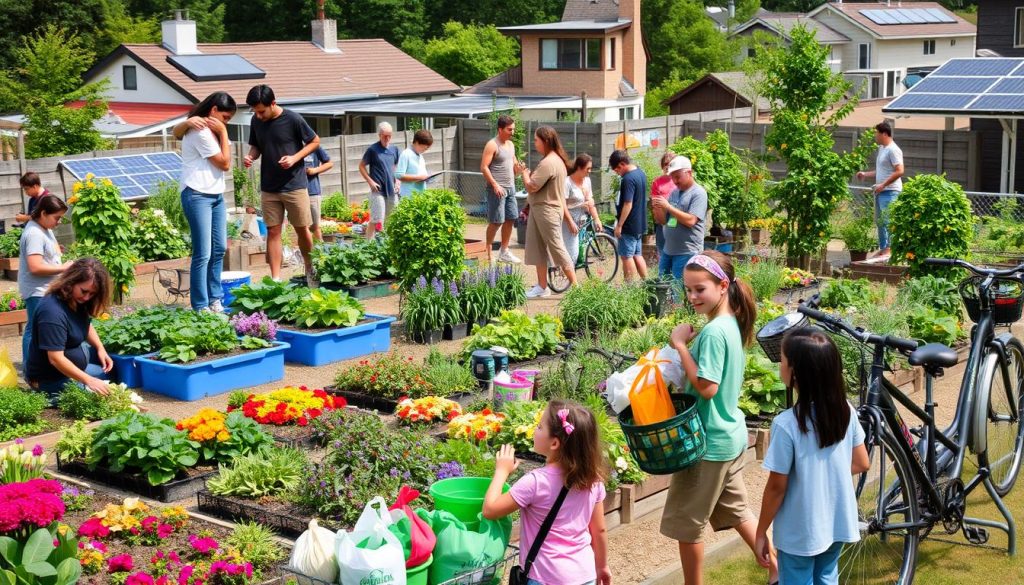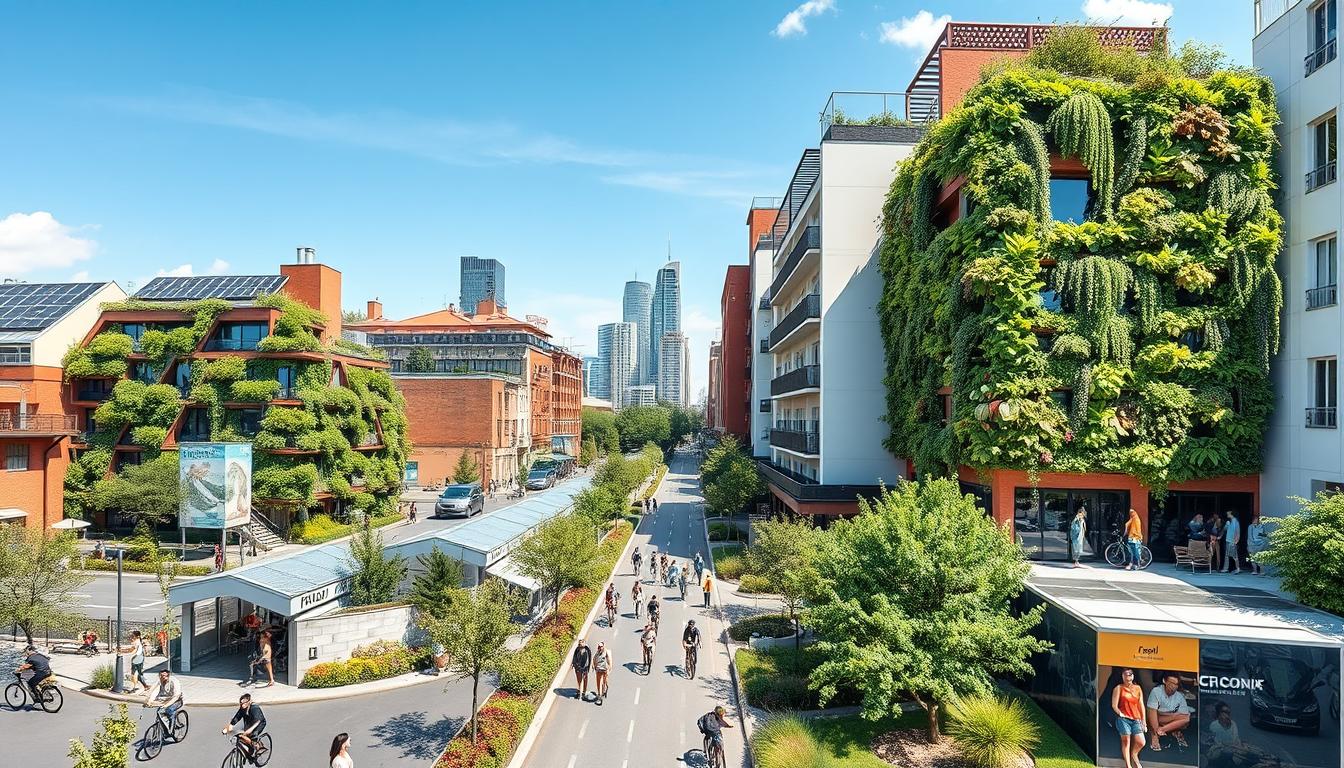In today’s fast-growing cities, the idea of zero waste cities is key. These cities aim to get rid of all waste, helping our planet. They use smart planning to make sure products are used over and over, not thrown away.
Research shows zero waste cities are good for the environment. They show us how to grow cities without harming nature. Let’s look at how these cities work and why they’re important for our planet.
What Are Zero Waste Cities?
Zero Waste Cities aim to get rid of waste by using sustainable ways to manage waste. They work on reducing, reusing, and recycling materials. This ensures waste is cut down and resources are used wisely.
Definition and Principles
A Zero Waste City, as defined by the Zero Waste International Alliance, aims to save all resources. It does this by promoting responsible production, consumption, reuse, and recovery. This means no waste is sent to land, water, or air that harms the environment or human health.
The main principles include cutting down waste, making products last longer, and getting the community involved. This helps achieve zero waste goals.
Importance of Sustainability
Sustainability is key for Zero Waste Cities. Good waste management protects the environment, saves natural resources, and cuts down on greenhouse gases. The U.S. Environmental Protection Agency says it also boosts public health and creates jobs in recycling and other green industries.
The Circular Economy Concept
The circular economy is at the heart of zero waste efforts. It keeps materials in use for as long as possible, getting the most value before recycling them. The Ellen MacArthur Foundation supports cities that aim to eliminate waste and restore natural systems.
This fits perfectly with sustainable waste management goals. It turns waste into valuable resources and creates a world where nothing is wasted.
Benefits of Going Zero Waste
Adopting zero waste strategies can change our lives in many ways. This section explores the environmental, economic, and social gains of striving for waste-free communities. By using effective waste reduction strategies, we can create a greener, more sustainable urban environment for all.
Environmental Impact
Zero waste cities have a big positive effect on the environment. Studies by the World Bank Group show that waste reduction leads to less pollution and resource use. By cutting down on landfill waste, we lower greenhouse gas emissions and save natural resources. This makes our cities more sustainable and eco-friendly.
Economic Advantages
Going zero waste also brings big economic benefits. Research by Resource Recycling Systems shows it can save a lot on waste management costs. It also creates jobs in recycling and sustainable products. So, communities can grow economically while living more sustainably.
Social Benefits for Communities
The social benefits of zero waste efforts are huge. They bring people together as they work towards environmental goals. Cleaner, healthier places and new jobs improve life quality and community spirit. As Global Citizen points out, waste-free communities have stronger social bonds and a sense of belonging.
Challenges in Achieving Zero Waste

Modern cities face big hurdles in reaching zero waste. We need to understand how things like infrastructure, public knowledge, and laws affect progress. This shows how complex and wide-ranging this goal is.
Infrastructure Limitations
One big problem is the old waste systems in many cities. These systems can’t easily switch to new, green ways without a lot of money and changes. The U.S. Environmental Protection Agency says making recycling and waste facilities modern is key but it’s hard.
Public Awareness and Education
Getting people to know about zero waste is also a big challenge. Many don’t understand the benefits or how to help. The National League of Cities says teaching communities can really help. When people know more, they recycle better and support green efforts more.
Policy and Regulation Hurdles
Dealing with laws and rules is another big challenge. Different rules at local, state, and federal levels can help or hurt zero waste goals. The World Bank says we need clear policies that encourage green changes. Making these rules work together is key to making a big difference.
Case Studies of Successful Zero Waste Cities

Looking at zero waste success stories gives us insights. It shows how cities worldwide have joined global zero waste efforts. They’ve turned into circular economy cities.
San Francisco: A Pioneering Example
San Francisco is a leader in zero waste efforts. It has reduced waste by over 80%. The city requires recycling and composting and invests in education.
These steps have made San Francisco a role model for others. It shows how cities can achieve similar goals.
Capannori, Italy: A Global Leader
Capannori, Italy, was one of the first European cities to go zero waste. It focused on reducing, reusing, and recycling waste. This led to diverting 40% of solid waste in a few years.
The local officials and community played a big role. Ongoing education keeps the community engaged and successful. Capannori’s journey has inspired many cities in the Zero Waste Europe network.
Kamikatsu, Japan: Innovative Waste Management
Kamikatsu, Japan, is known for its unique waste management. It has 45 categories for waste segregation. The town recycles most of its waste thanks to community dedication and effective policies.
Public participation is key in Kamikatsu. It encourages residents to sort and dispose of waste carefully. Kamikatsu is a global example of zero waste success.
| City | Key Initiative | Success Metrics |
|---|---|---|
| San Francisco | Comprehensive Waste Diversion Programs | 80% Waste Reduction |
| Capannori, Italy | Detailed Zero Waste Policy | 40% Waste Diversion |
| Kamikatsu, Japan | 45 Waste Segregation Categories | Significant Recycling Implementation |
Steps for My Community to Become Zero Waste

Creating a zero waste community is a big journey. It starts with checking our current waste habits, talking to local government, and getting everyone involved. Here’s a guide to help my community move towards a greener future.
Assessing Current Waste Management Practices
The first step is to look at how we manage waste now. Knowing where we are helps us see what needs to change.
- Identify the primary waste streams: residential, commercial, industrial
- Analyze current waste diversion rates and landfill usage
- Evaluate the effectiveness of current recycling and composting programs
By gathering data, we can make plans that fit our community’s needs.
Engaging with Local Government
Working with local government is key to making zero waste policies work. It’s important to work together with community members, officials, and waste experts.
- Advocate for the adoption of zero waste policies and ordinances
- Involve local officials in planning and strategy sessions
- Secure funding for zero waste initiatives from municipal budgets and grants
Getting local government on board helps us get the support and rules we need to succeed.
Building Community Support
Getting the community involved is the heart of any zero waste effort. Here’s how we can get people on board:
- Organize educational workshops and campaigns to raise awareness
- Establish volunteer groups to lead local zero waste efforts
- Host community events to show off successful waste reduction ideas
Sharing success stories from groups like U.S. Public Interest Research Group can motivate our community. When people are involved, reaching our zero waste goals is easier.
| Action | Stakeholders | Outcome |
|---|---|---|
| Assess Waste Practices | Local Government, Waste Management Experts | Identification of Improvement Areas |
| Engage Local Government | Community Members, Officials | Adoption of Zero Waste Policies |
| Build Community Support | Residents, Volunteers | Increased Awareness and Participation |
By following these steps, my community can start its journey to zero waste with a clear plan and strong support.
Innovative Solutions for Waste Reduction
One way to reach zero waste in cities is by using new waste solutions. These include composting, turning waste into energy, and upcycling. Upcycling and repair cafés also play a big role. These strategies help cities reduce their environmental impact and promote sustainable living.
Composting Initiatives
Composting is becoming more common as a way to manage waste. It turns organic waste into soil that helps plants grow. In Austin, Texas, composting has cut waste by up to 30%.
The compost is used in gardens, parks, and farms. This not only helps the environment but also brings people together.
Waste-to-Energy Technologies
Waste-to-energy technologies are another big step in reducing waste. They turn waste into heat, electricity, or fuel. Minneapolis has seen a big drop in landfill waste thanks to these systems.
These technologies can power thousands of homes. They show how reducing waste can also produce energy.
Upcycling and Repair Cafés
Upcycling and repair cafés are creative ways to reduce waste. Upcycling turns old materials into new things. Repair cafés help people fix items instead of throwing them away.
These ideas not only cut down on waste but also teach people to be creative and self-sufficient.
- Enhancing community involvement in waste reduction.
- Providing educational platforms for innovative waste solutions.
- Encouraging sustainable lifestyles through practical workshops.
| Innovative Waste Solution | Environmental Impact | Economic Impact |
|---|---|---|
| Community Composting | Reduces landfill waste, enriches soil, improves local greenery | Cost savings on waste disposal, potential revenue from compost sales |
| Waste-to-Energy | Decreases landfill volume, generates renewable energy | Lowers energy costs, creates jobs in technology and maintenance |
| Upcycling | Minimizes waste, conserves resources | Promotes local crafts and businesses, reduces new material costs |
| Repair Cafés | Reduces landfilled items | Saves money on replacements, fosters local expertise |
Future of Zero Waste Cities
The idea of zero waste cities is changing fast. New trends and tech, like those from the World Economic Forum, show a bright future. We’ll see better ways to turn waste into energy and recycle more. Plus, people are moving towards simpler living, which helps too.
Potential Trends and Developments
Zero waste efforts are growing fast. Cities will use circular economies more, where things are reused and recycled. Smart waste systems and energy plants will play big roles. Also, more people will focus on taking care of the planet in their daily lives.
My Role in Promoting Zero Waste
We all play a big part in making zero waste a reality. By living sustainably, we help our communities. Simple steps like composting and using less plastic help a lot. Joining local groups and pushing for zero waste policies also matters a lot.
Impact on Global Sustainability Efforts
Zero waste cities help the world a lot. They cut down on pollution and greenhouse gases. The United Nations says this is key to fighting climate change and saving nature. Zero waste cities show us how to live better for the future.
